More shoppers are now turning to ChatGPT to find products. OpenAI’s recent “Buy it in ChatGPT” launch makes chat-based shopping smoother than ever. Customers can search, choose, and pay for products without leaving the conversation. It’s the first real step toward agentic commerce and the next phase of conversational commerce.
Understanding how it works helps eCommerce teams connect their systems to handle new sales coming directly from ChatGPT.
Key takeaways
- Agentic commerce allows customers to buy products directly inside ChatGPT.
- OpenAI launched Instant Checkout with Etsy and plans to expand to Shopify and more platforms.
- Brands on Magento / Adobe Commerce don’t need to replatform to enable this channel, but integration requires a product feed, checkout API, delegated payment flow, and webhooks.
- Early adoption gives merchants visibility in AI-driven product discovery.
What is agentic commerce?
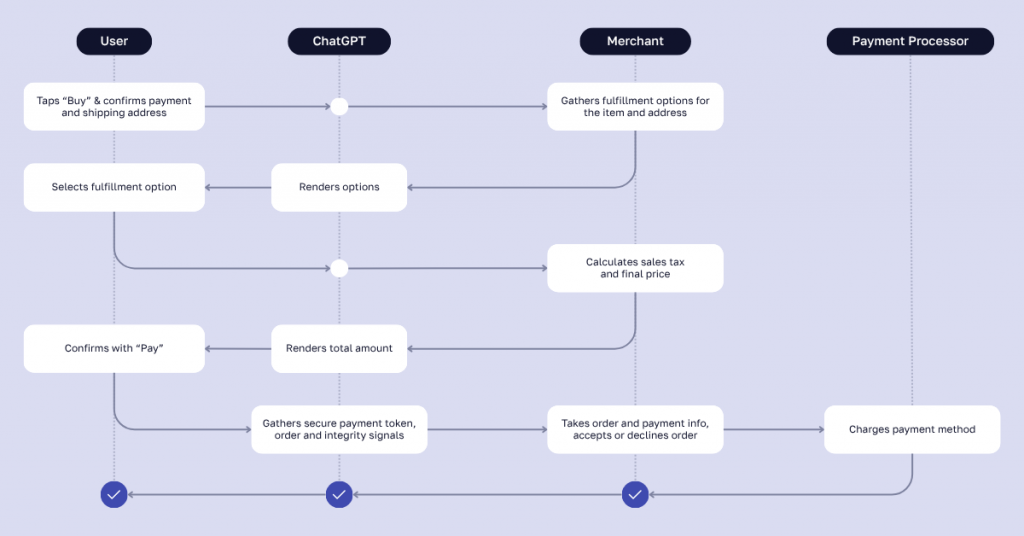
Agentic commerce is the ability to discover and buy products directly inside an AI chat like ChatGPT.
Think of it as an AI shopping assistant that doesn’t just recommend items but completes the purchase for you. The customer stays in the conversation, confirms what they want, and approves payment while the AI securely coordinates the checkout with the merchant’s backend.
Agentic commerce isn’t a scripted dialog that redirects users to a site. It’s a fully functional shopping flow managed by an AI agent following open standards like the Agentic Commerce Protocol (ACP). The merchant still processes the order and handles fulfillment, while ChatGPT acts as the user’s assistant, not a middleman.
“Buy it in ChatGPT” at a glance
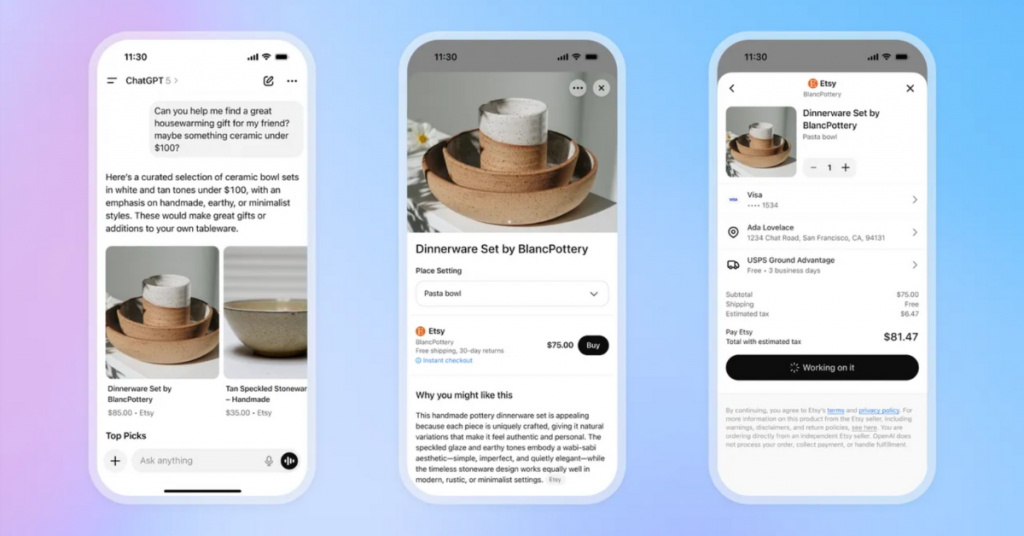
OpenAI’s “Buy it in ChatGPT” feature is the first live example of this model. With Instant Checkout, users can find a product and complete payment in the same chat. ChatGPT sends the order directly to the merchant, who fulfills it through their existing systems.
It’s a single, continuous conversation that takes the user from search to purchase.
Also read:
Chat to Buy: The Future of eCommerce Is Conversational
How “Buy it in ChatGPT” works
The Instant Checkout process follows four stages: discovery, checkout session, delegated payment, and fulfillment. Each stage connects ChatGPT to the merchant’s systems through standardized APIs defined in the ACP.
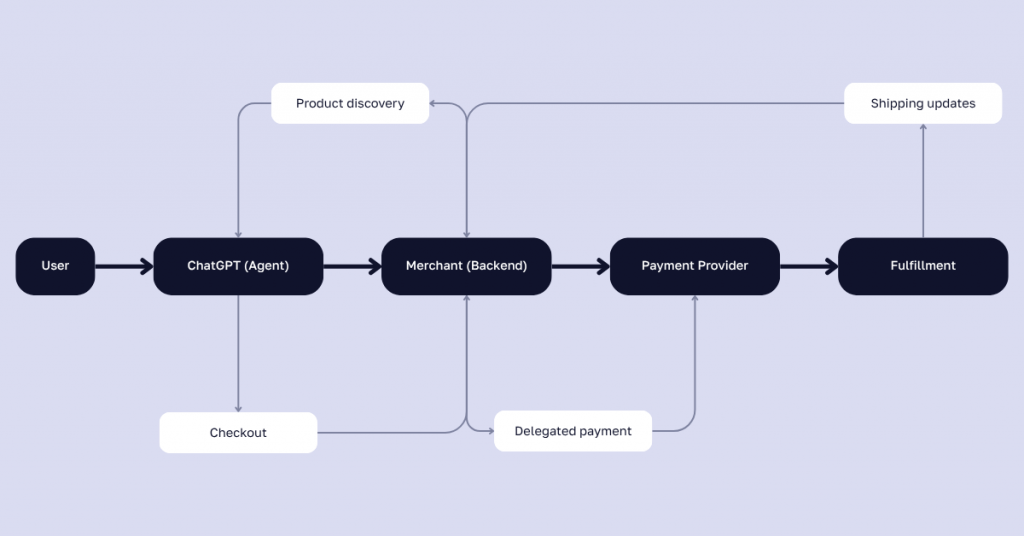
The AI guides the user through product discovery, builds an order via secure API calls, hands off a payment token, and notifies them once the merchant confirms shipment.
Product discovery
ChatGPT starts the journey with a product feed provided by the merchant. The feed includes titles, prices, stock levels, and images, refreshed frequently to stay accurate. ChatGPT uses this feed to show relevant results and only displays a “Buy” button when an item is available and supports Instant Checkout.
In simple terms, the feed replaces the product page: it’s how the AI knows what’s for sale and whether it’s in stock. Keeping that data clean and current ensures every purchase maps to a valid product.
Checkout sessions
When the shopper clicks “Buy” in the chat, ChatGPT sends a secure API request to the merchant’s system to create a new checkout session.
The merchant’s backend (Adobe Commerce, Shopify, etc.) stores the order details like product, quantity, shipping, taxes, and sends back a structured response. ChatGPT uses that response to guide the shopper through the rest of the checkout steps (address, shipping, payment).
Each time the shopper confirms or changes something, ChatGPT sends another request to the same session on your system. And when the shopper approves payment, ChatGPT triggers the complete call, and your system finalizes the order.
If something goes wrong – say an item is out of stock or an address is invalid – ChatGPT shows the message right in the chat, so the user can fix it.
Payments
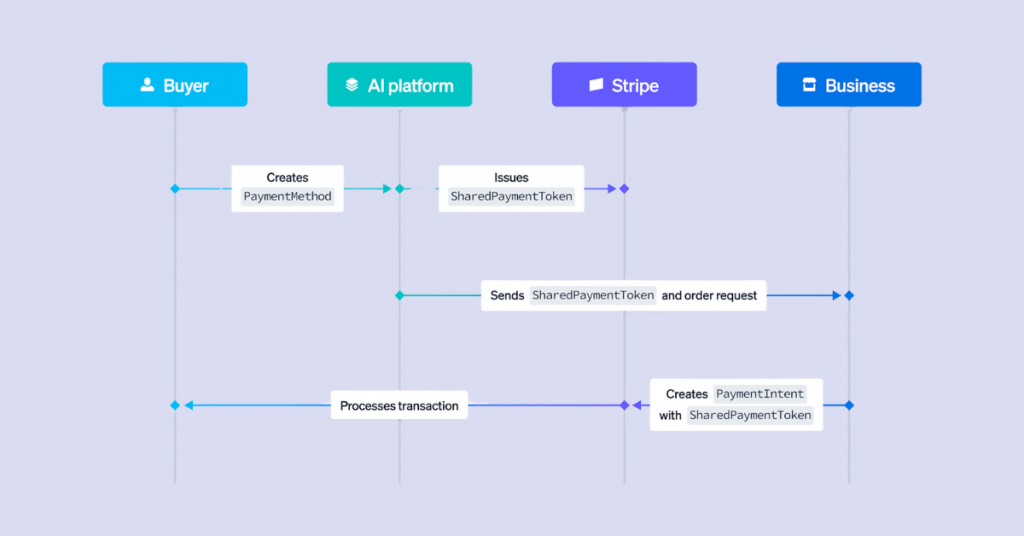
Payment is handled through delegated payments, not by ChatGPT itself. When the user chooses to pay, ChatGPT generates a Stripe Shared Payment Token (SPT) which is a secure, single-use token that represents the payment method. The token has a limited scope (merchant, amount, expiration) and contains no raw card data, keeping PCI scope minimal.
The merchant’s backend redeems the token via Stripe or another payment service provider to process the charge. While Stripe SPT is the first implementation, other payment service providers are expected to support the same standard. The merchant still reconciles, settles, and refunds directly through their payment system.
Fulfillment and order updates
After payment, the order enters the merchant’s normal fulfillment flow. The merchant sends order webhooks back to OpenAI to keep the chat updated with real-time status: created, confirmed, shipped, or canceled. Each event is signed for verification and retried automatically if delivery fails.
The user can check their order status in ChatGPT, receiving messages like “Your order has shipped” or “Delivery expected tomorrow.” This keeps customers informed after purchase without needing to visit another site or app.
🚀 Quick takeaway
ChatGPT acts as the storefront while the merchant’s system handles the transaction. The AI shows available products, creates the order, passes a secure payment token, and updates the buyer once the order ships.
Who can sell via ChatGPT today?
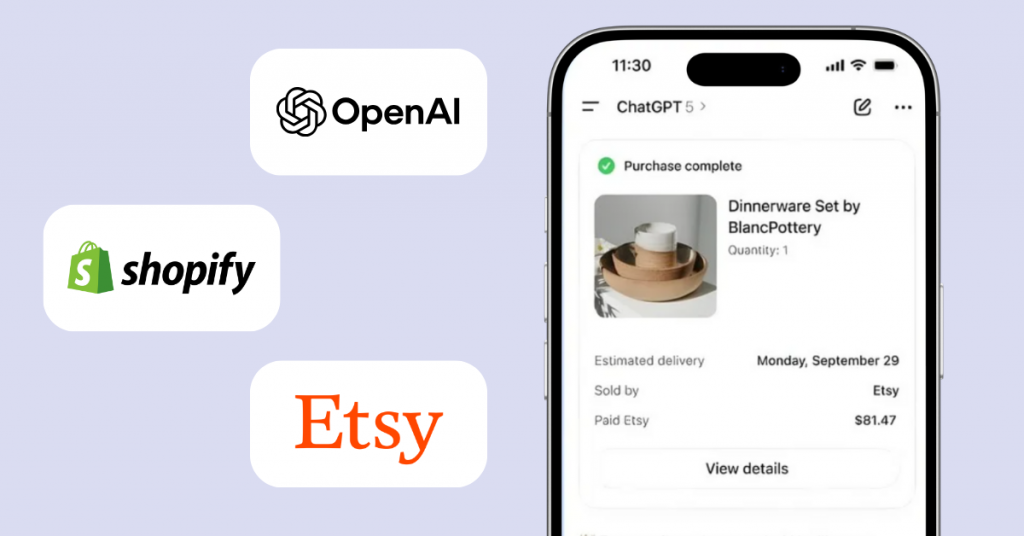
Right now, Instant Checkout is live for U.S.-based Etsy sellers, making their listings available for direct purchase inside ChatGPT. Shopify merchants are next in line, with testing already under way and broader access expected soon.
At launch, Instant Checkout supports single-item purchases only (one product per order) but OpenAI’s roadmap includes multi-item carts, expanded categories, and more regions beyond the U.S. Over time, other platforms and enterprise merchants will be able to join by implementing the open Agentic Commerce Protocol.
🚀 Quick takeaway
Instant Checkout is still limited to U.S. merchants, but expansion is coming fast. Brands that clean up product data and build checkout APIs now will be first in line when ChatGPT shopping opens to new regions and platforms.
Why it matters for merchants
Agentic commerce gives brands a new way to sell without changing their existing store setup. It cuts down the steps between interest and purchase. With ChatGPT checkout, a shopper can complete an order the moment they decide to buy.
You stay the merchant of record, running payments, taxes, fulfillment, and support through the systems you already use. There’s no need to move platforms or change providers.
In today’s market, we can’t ignore the fact that shoppers will always choose the easiest option. Making checkout faster and simpler can be the difference between gaining a customer and losing one.
Beyond higher conversions, agentic commerce also means you:
- Keep full control of customer data and post-purchase communication
- Reach new audiences through AI-driven product discovery
- Continue using your existing platform and payment provider
- Gain an early-mover advantage as this new buying model becomes the norm.
🚀 Quick takeaway
Agentic commerce pays off over time: faster checkouts, repeat customers, and stronger visibility in AI search. However, success still depends on the basics like having clean data, reliable systems, and clear metrics.
Also read:
Case Study: Conversational Commerce Brings 31% of Churned Customers Back
Integrating agentic commerce with Adobe Commerce/Magento
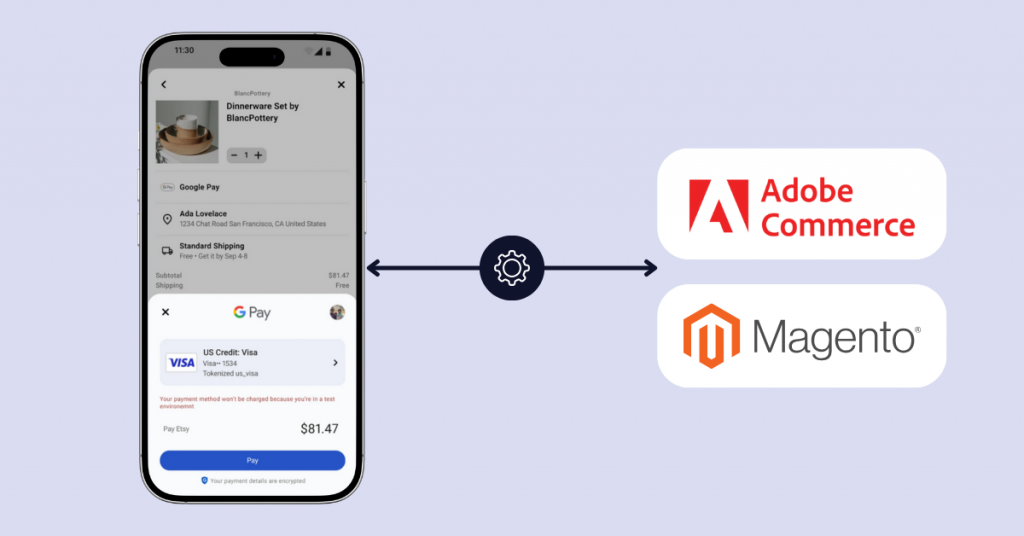
Enterprise merchants on Adobe Commerce (Magento) can enable agentic commerce without replatforming. Magento already has most of what you need – a product catalog, order management, and APIs. The job is to create a few new connections, so ChatGPT can talk to your store using the Agentic Commerce Protocol.
Here’s what needs to be in place:
- A clean, regularly updated product feed that includes product titles, prices, stock levels, and images. This is how ChatGPT knows what’s available to buy.
- A checkout sessions API that allows ChatGPT to create, update, and complete orders, validating addresses and shipping options while avoiding duplicate orders.
- A payment module that supports secure, one-time payment tokens (like the Stripe Shared Payment Token) so charges happen safely without exposing card data.
- Order webhooks that send real-time updates back to ChatGPT when an order is created, shipped, or canceled, with automatic retries for reliability.
- Monitoring and logging to track API errors, webhook delivery, and system performance, alerting your team if something slows or fails.
You’ll need a small team to make it happen: a backend developer to build the APIs, a payments engineer to handle the delegated payment flow, DevOps to manage performance and monitoring, a security lead to review PCI compliance, and QA to test everything in a sandbox before launch.
All of this happens in the backend. Once live, these updates connect your Magento store directly to ChatGPT, allowing shoppers to discover and buy your products inside the chat.
Also read:
Top 16 AI Agent Development Companies in 2025
Security, PCI, and fraud
Handling payments through ChatGPT introduces a new connection between systems, so security needs clear attention from the start.
Tokenization keeps card details out of Magento. ChatGPT never stores or sends raw card numbers. Instead, it uses a Stripe Shared Payment Token which is a single-use code linked to a specific merchant, amount, and expiration. Magento’s existing Stripe integration redeems this token to process the payment, meaning sensitive data never passes through your servers.
To strengthen security even further:
- Turn on 3D Secure (3DS) or Strong Customer Authentication (SCA) where regulations require it
- Keep your payment provider’s fraud checks active: address verification, velocity limits, and risk scoring still apply
- Log API calls and webhook events with sensitive details masked so you can trace issues without exposing data
- Test everything in a sandbox before launch, including failed sessions, expired tokens, and duplicate transactions.
Costs, timelines, and KPIs
Adding Instant Checkout to Magento or Adobe Commerce doesn’t mean rebuilding your store. The time and cost of integration depend on how much you choose to pilot and how ready your systems are.
A small pilot covering one product line typically takes 4–8 weeks with a backend developer, a payments engineer, and QA. Expanding to your full catalog with monitoring and automated testing may take up to 10–14 weeks.
At the moment only approved white-label merchants can participate in Buy it in ChatGPT. Merchants need to apply and be accepted into the program through OpenAI’s official merchant portal.
Fees are straightforward. OpenAI applies a small per-transaction fee for Instant Checkout, while payment processing continues through your existing provider (like Stripe, Adyen, or Braintree) at their usual rates. There are no extra licenses or platform fees.
Once live, track performance using a few key agentic commerce metrics:
- Conversion rate
- Average order value (AOV): whether chat-based orders are larger or smaller than your site’s average
- Time to checkout
- Incremental revenue: whether sales come from new customers or existing ones
- CAC payback: how quickly you recover acquisition costs through completed sales.
Also monitor operational metrics like API uptime, webhook delivery, and refund speed. Together, these show how well your agentic commerce channel performs and where to focus improvements.
Build your integration vs buy
The choice between building your own integration or using an existing one depends on how quickly you want to launch and how much control you need. Magento’s flexibility allows both.
If your goal is speed, start with an existing agentic commerce Magento module. You can install an open-source ACP extension, connect your product feed, and configure checkout endpoints in a matter of weeks. It’s the fastest way to test Instant Checkout with minimal engineering effort.
If you need control, a custom integration is the better route. Developers can build APIs and webhooks directly into Magento, tailor them to your payment provider and ERP, and optimize for performance, error handling, and logging. This path takes longer but gives you full ownership of architecture and data flow.
If you prefer a turnkey rollout, work with an implementation partner familiar with Magento and ACP like scandiweb. A partner can coordinate between your eCommerce, payments, and operations teams, ensuring delegated payments, feeds, and webhooks all run smoothly.
Also read:
Top AI Agencies in 2025: Who’s Leading AI Strategy & Development
Many merchants take a hybrid approach: launch quickly with a module, then extend it to meet enterprise requirements and brand logic once results justify scaling.
And if your store runs on Hyvä, there’s no conflict. Hyvä handles the frontend; agentic commerce sits entirely on the backend. Your site design, checkout styling, and user experience remain untouched.
🚀 Quick takeaway
Whether you build, buy, or partner with an agency, Magento supports all paths, but success comes down to three things: clean data, reliable APIs, and clear ownership.
Risks, limitations, and how to mitigate
Like any new channel, Instant Checkout comes with some constraints. Understanding them early helps teams prevent avoidable downtime and protect the buyer experience.
Single-item checkout
Right now, shoppers can only purchase one product per transaction. Treat it as a pilot opportunity: focus on your bestsellers, curated bundles, or limited collections. Then, use post-purchase messaging or email flows to cross-sell complementary products.
Regional and merchant availability
Instant Checkout is currently limited to U.S. merchants and buyers and is available only to approved white-label merchants. Wider access and regional expansion are expected later, so it’s worth preparing your systems now for localization, taxes, and currency handling.
Catalog accuracy
Out-of-date stock or incorrect prices will cause failed orders. Automate product feed refreshes every 10–15 minutes and validate stock during each checkout session. A clean, accurate feed is the single best defense against order errors.
Error handling
Delays or missing data can break the checkout flow. Build your integration so it can safely retry the same request without creating duplicate orders, and make sure any error messages are clear enough for ChatGPT to show the user what went wrong.
API performance and uptime
Fast responses keep checkout smooth. Try to keep your integration’s response time under half a second and monitor it constantly. Set up simple alerts so your team knows right away if requests slow down or fail.
Support and refunds
Some users may message ChatGPT instead of your support team. Include clear order confirmation and contact details in every response, and ensure webhook updates sync with your helpdesk or CRM, so customer service stays consistent.
🚀 Quick takeaway
Stay ahead of issues by testing early, monitoring often, and keeping teams in sync. Clean data, clear error handling, and daily checks turn Instant Checkout from a risky pilot into a reliable new sales channel.
Action plan: 7 steps to launch Instant Checkout
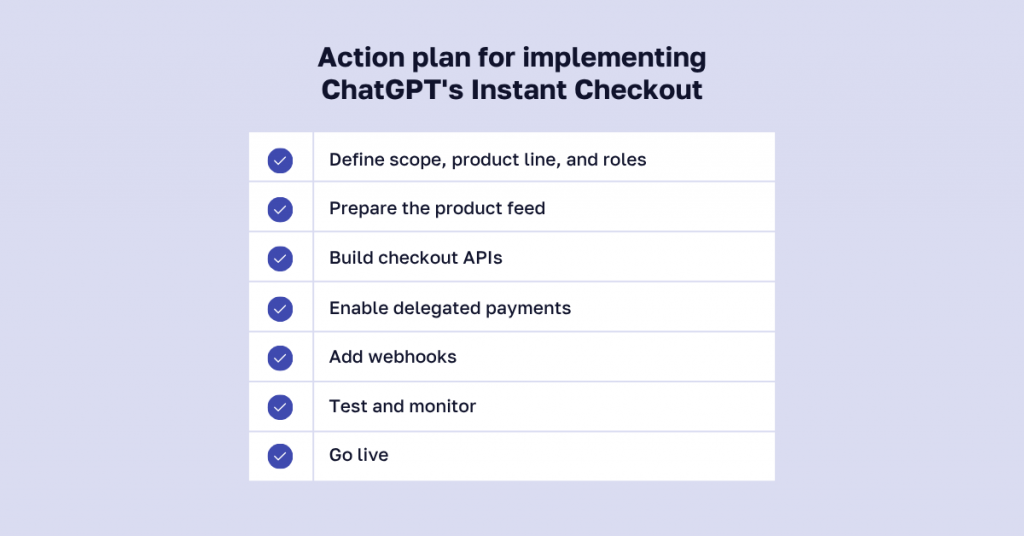
A structured rollout keeps the project moving smoothly from idea to live orders. Use these steps to enable Instant Checkout on Magento or Adobe Commerce:
- First, apply for approval from OpenAI. Only accepted white-label merchants can currently participate in Buy it in ChatGPT, so start by submitting your application at chatgpt.com/merchants.
- Choose a product line for the pilot and assign clear owners for backend, payments, QA, and security.
- Make sure you have a clean, accurate product feed with titles, prices, stock, and images, updated every 10–15 minutes.
- Build and test checkout APIs that create, update, and complete orders, including proper validation and error handling.
- Connect your payment provider and set up Stripe Shared Payment Token or another secure token system for delegated payments.
- Send order updates such as created, shipped, and canceled to ChatGPT, and add automatic retries for failed deliveries.
- Run sandbox tests to monitor speed and reliability, then set up alerts for any failed or slow requests.
- Review security, switch to production, brief support, and start tracking performance after go live.
Most teams can complete this in four to eight weeks. Partnering with an experienced Magento and ACP team can speed up delivery, reduce errors, and ensure your integration is ready for scale from day one.
Conclusion
Agentic commerce has already changed how people shop. Joining Instant Checkout keeps your brand visible where customers are already making purchase decisions, while you keep control of payments, orders, and data.
To get started, prepare your agentic commerce checklist, make sure your integrations work correctly, and track early results to see the impact.
Ready to integrate ChatGPT Instant Checkout in your store? scandiweb is the world’s most certified Magento / Adobe Commerce agency with proven experience in AI-driven commerce. Contact us to get a clear, step-by-step roadmap for integrating agentic commerce and turning ChatGPT into a new sales channel for your brand.
Frequently asked questions
Do I need to replatform for agentic commerce?
No. You can enable Instant Checkout on your existing Magento, Shopify, or Salesforce Commerce Cloud store by adding new APIs and a product feed. Your core systems, checkout logic, and payment provider stay the same.
Who owns the customer in ChatGPT checkout?
You do. The merchant remains the merchant of record, owning customer data, payment processing, and fulfillment. ChatGPT only facilitates the conversation and securely passes the order details.
How do refunds and returns work in agentic commerce?
Refunds and returns follow your existing process. The merchant initiates them through their payment provider and updates the user through webhooks or email, just like any other online order.
How do payments work in ChatGPT Instant Checkout?
Payments use delegated tokens issued by your PSP. The customer approves the purchase in ChatGPT; the merchant redeems the token to capture the payment on their existing account.
How long does agentic commerce integration take?
A focused pilot can go live in 4–8 weeks. Most of the effort is backend work: building checkout endpoints, testing delegated payments, and configuring webhooks for order updates.
What’s different for Magento vs Shopify merchants?
Shopify and Etsy merchants are pre-integrated with OpenAI. Magento merchants can join by implementing the open Agentic Commerce Protocol. It’s flexible, self-hosted, and works with any PSP.
How do order webhooks work in agentic checkout?
Webhooks send order status updates (created, shipped, canceled) from your system to ChatGPT. They keep the user informed in real time and mirror your standard OMS or ERP events.
Will agentic commerce cannibalize my site traffic?
Unlikely. Agentic commerce creates a new purchase path for customers who already use AI to shop. It complements your store and adds incremental conversions, not competition.
How does ChatGPT handle taxes and shipping?
Your system calculates both. ChatGPT passes the address; your checkout session returns tax and shipping totals so the customer sees accurate costs before confirming.
Can I customize the checkout flow?
Yes. You control available shipping options, payment methods, and order rules. ChatGPT simply reflects what your API provides.
What happens if an API call fails during checkout?
ChatGPT displays the error message returned by your endpoint, and the user can retry. Use idempotent requests and detailed error codes to ensure clean recovery.
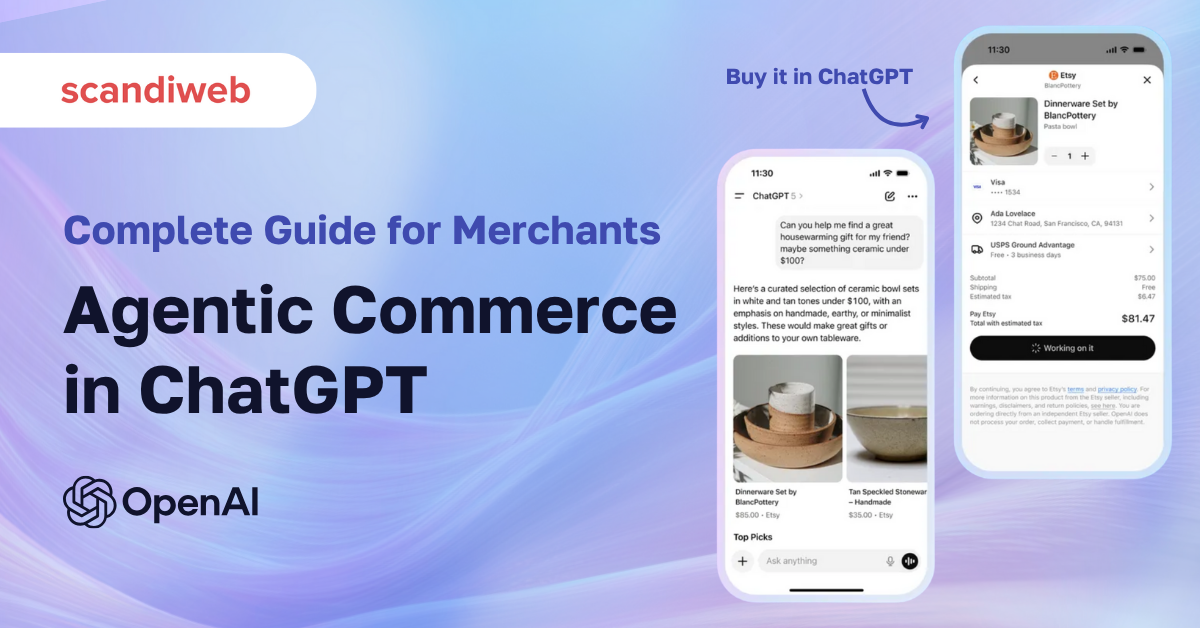

Share on: